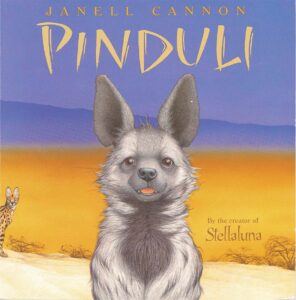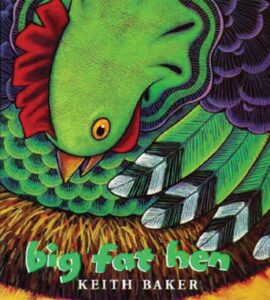Oral language, Print knowledge
Children will understand how Janell Cannon uses drawing to tell stories about animals.


New:
Review:

We are learning about Janell Cannon and the books she writes. She writes books about animals. She wants the illustrations in her books to help tell the story.
 Yesterday we read Stellaluna. Remember, Stellaluna is a bat.
Yesterday we read Stellaluna. Remember, Stellaluna is a bat.
Today we will read a book called Pinduli. This is a book about a hyena. A hyena is an animal that is about the size of a big dog. In this book, the hyena lives on a savanna in Africa. Africa is a huge area of land on our earth. The savanna is a flat landform with few trees.
[Display book cover. Point out that the illustration shows a hyena.]
Let’s read this book and see what happens.
[Read the book without inviting talk until you have finished reading. Do not elaborate on book information unless children seem confused about what you are reading. Point to and describe illustrations directly related to the text.]
There were many different kinds of animals in this story. Which animals do you remember? (Pinduli the hyena, dogs, lion, zebra, fox, vulture, owl)
These are all real animals. They all live on a savanna in Africa.
Janell Cannon says that she often gets the ideas for her books by going to the zoo. A zoo is a place where we can go to see lots of different animals.
When Ms. Cannon is at the zoo, she watches the animals very carefully. She gets ideas for her stories by first making sketches of animals. A sketch is a rough drawing. It is not finished. Drawing helps Ms. Cannon to stretch her imagination to create a story. Let’s look inside the cover of the book to see some of her sketches.
[Point to sketches inside the cover of the book.]
What animals do you see here? (lion, zebra, owl, snake, dog, fox, hyena)
Janell Cannon says that she wants her drawings to help people begin to like different kinds of animals. She wants her illustrations and books to help us better understand animals that may make us feel uncomfortable or scared.
Today we read another book by Janell Cannon. Pinduli is a story about an animal called a hyena that lives on a savanna in Africa. Some of the things in the story were facts. They were true and some things in the story were not true. They were fiction. We also learned that Ms. Cannon tries to use her illustrations to help people like animals that they were once afraid of. Ms. Cannon first makes sketches of animals. A sketch is a rough drawing. It is not a finished drawing.
Extra support
Enrichment
Provide books about animals that are probably unfamiliar to children in your room. Examples: Platypus! (Step into Reading) by Ginjer L. Clarke and “Slowly, Slowly, Slowly,” said the Sloth by Eric Carle.
School-age children might wish to look at books about animals that are unfamiliar to children in your setting and enjoy talking with preschool-age children about what they find.
Number knowledge
Children will practice forming equal groups.


Review:
Offer the Week 8, Day 4 activity to review forming groups that are equal.
Engage children in making two groups of items, each equal to a different numeral in a book.
 Introduce Big Fat Hen. Explain it is a book about numbers. We will pause while we read the book to make groups equal to the numbers we read in the book. Ask children what it means when things are equal. (they are the same)
Introduce Big Fat Hen. Explain it is a book about numbers. We will pause while we read the book to make groups equal to the numbers we read in the book. Ask children what it means when things are equal. (they are the same)
Give each child 19 counters. Read the page that says, “1, 2.” Invite children to make a group of one counter and a second group of two counters. After children make their groups, reread the page with numbers, point out that each number shown on the page is equal to one of our groups, and read the following page.
Continue the process described above, beginning on each page that displays two numbers. Stop making groups when you reach the page that says “and her friends.”
At the conclusion of the book, remind children that we made groups that were equal to numbers on a page. Then ask whether the two groups we made for each page were equal. (no, our groups had different numbers of counters; each group was equal to a number on a page)
Executive function
Children will understand how to focus on facial expressions of others.


Review:
Be Prepared: If time permits, offer It’s Raining, It’s Pouring from Week 44, Day 1 as a second game. If the game described below is too challenging for a majority of children, stop at an appropriate place and offer It’s Raining, It’s Pouring from Week 44, Day 1. The game for today may be less challenging when offered again at a later point.
[Arrange children so they are sitting in a circle on the floor.]
We are learning about many different emotions. We know what it means to feel silly. Remember, we feel happy and playful when we feel silly. Let’s all show our silly faces!
Today we are going to sing a song we’ve sung before. It’s the “Silly Faces Song.”
What do we do when we sing the “Silly Faces Song”?
Each of us will get a turn to make a silly face while we sing the “Silly Faces Song.” We know there are many different types of silly faces we can make!
Now (adult helper) and I are going to sing the song first to remind you of what to do.
[The “Silly Faces Song” is sung to the tune of “Mary Had a Little Lamb.” Sing the following song using the adult helper’s name:]
“_____ make a silly face, silly face, silly face. _____ make a silly face, watch and copy her!”
[Invite children to imitate the adult helper’s silly face.]
Remember, each time we sing the song, we will use the name of a different child in our circle. The child we name will make a silly face and then the rest of us will copy the silly face. We need to make sure we are paying attention so we know what kind of silly face to make. Remember, we need to wait patiently for our turn. If you do not wish to make a silly face when it is your turn, just say “no thank you.”
Let’s try it together!
[Lead children in singing the song as you move around the circle from child to child. As each child takes his/her turn making a silly face, encourage the other children to imitate the silly face.
If a child chooses not to make a silly face, that is okay. Move to the next child in the circle. Continue until you have sung each child’s name. If children who did not initially want to make a silly face wish to do so after all other children have gone, invite them to do so.]
Now we are going to change our song a little. This time we are going to call our song the “Sad Faces Song.” When we sing the “Sad Faces Song,” we will each get a turn to make a sad face. Show us your sad face! Let’s try it!
[Lead children in singing the song as you move around the circle from child to child. As each child takes his/her turn making a sad face, encourage the other children to imitate the sad face.
If a child chooses not to make a sad face, that is okay. Move to the next child in the circle. Continue until you have sung each child’s name. If children who did not initially want to make a sad face wish to do so after all other children have gone, invite them to do so.]
Today we practiced paying attention to other children and copying someone else’s silly and sad face!
Extra support
Enrichment
Encourage children to continue the “Sad Faces Song.” Invite children to change the song to include options other than making a sad face. Examples: doing a sad dance or moving in a sad way.
Sing the “Sad Faces Song” while outside. Encourage children to mimic each other while playing on the swings or playing with a ball.
Knowledge of earth and space
Children will strengthen their understanding of external characteristics of rocks.


Review:

We are learning about rocks.
[Give each child the baggie containing the rock he/she found yesterday, plus the child’s science journal. Invite children to remove their rock from its baggie.]
Today we will use a magnifying glass to look at our rocks, and then we will draw a picture of our rock in our science journal.
How does a magnifying glass help us see things better? (can see things up close)
Let’s look closely at our rock before we begin drawing a picture of our rock. Let’s focus on our rock’s color, shape, and size. These are characteristics of our rock that we could include in our drawing. Remember, a characteristic is something special about our rock.
[As children draw, gently mention some rock characteristics they may wish to include in their drawing: color, shape, size.]
Today each of us looked closely at characteristics of our rock using a magnifying glass. We then drew a picture of our rock in our science journal. Who would like to tell us what is interesting about their rock?
Extra support
Enrichment
Supply a collection of rocks, glue, googly eyes, markers, and other decorative items that can be used to decorate a “pet rock.”
Encourage pairs of children to look closely at each other’s rock to compare characteristics. How are the two rocks similar and different?